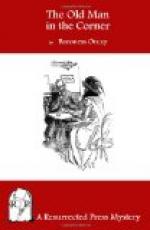“Lord Arthur had been obliged to stay in York a few days, as his evidence would be needed. That fact gave the case, perhaps, a certain amount of interest as far as York and London ‘society’ were concerned. Charles Lavender, moreover, was well known on the turf; but no bombshell exploding beneath the walls of the ancient cathedral city could more have astonished its inhabitants than the news which, at about five in the afternoon on the day of the inquest, spread like wildfire throughout the town. That news was that the inquest had concluded at three o’clock with a verdict of ’Wilful murder against some person or persons unknown,’ and that two hours later the police had arrested Lord Arthur Skelmerton at his private residence, ‘The Elms,’ and charged him on a warrant with the murder of Charles Lavender, the bookmaker.”
CHAPTER VIII
THE CAPITAL CHARGE
“The police, it appears, instinctively feeling that some mystery lurked round the death of the bookmaker and his supposed murderer’s quiet protestations of innocence, had taken a very considerable amount of trouble in collecting all the evidence they could for the inquest which might throw some light upon Charles Lavender’s life, previous to his tragic end. Thus it was that a very large array of witnesses was brought before the coroner, chief among whom was, of course, Lord Arthur Skelmerton.
“The first witnesses called were the two constables, who deposed that, just as the church clocks in the neighbourhood were striking eleven, they had heard the cries for help, had ridden to the spot whence the sounds proceeded, and had found the prisoner in the tight grasp of Lord Arthur Skelmerton, who at once accused the man of murder, and gave him in charge. Both constables gave the same version of the incident, and both were positive as to the time when it occurred.
“Medical evidence went to prove that the deceased had been stabbed from behind between the shoulder-blades whilst he was walking, that the wound was inflicted by a large hunting knife, which was produced, and which had been left sticking in the wound.
“Lord Arthur Skelmerton was then called and substantially repeated what he had already told the constables. He stated, namely, that on the night in question he had some gentlemen friends to dinner, and afterwards bridge was played. He himself was not playing much, and at a few minutes before eleven he strolled out with a cigar as far as the pavilion at the end of his garden; he then heard the voices, the cry and the groan previously described by him, and managed to hold the murderer down until the arrival of the constables.
“At this point the police proposed to call a witness, James Terry by name and a bookmaker by profession, who had been chiefly instrumental in identifying the deceased, a ‘pal’ of his. It was his evidence which first introduced that element of sensation into the case which culminated in the wildly exciting arrest of a Duke’s son upon a capital charge.




